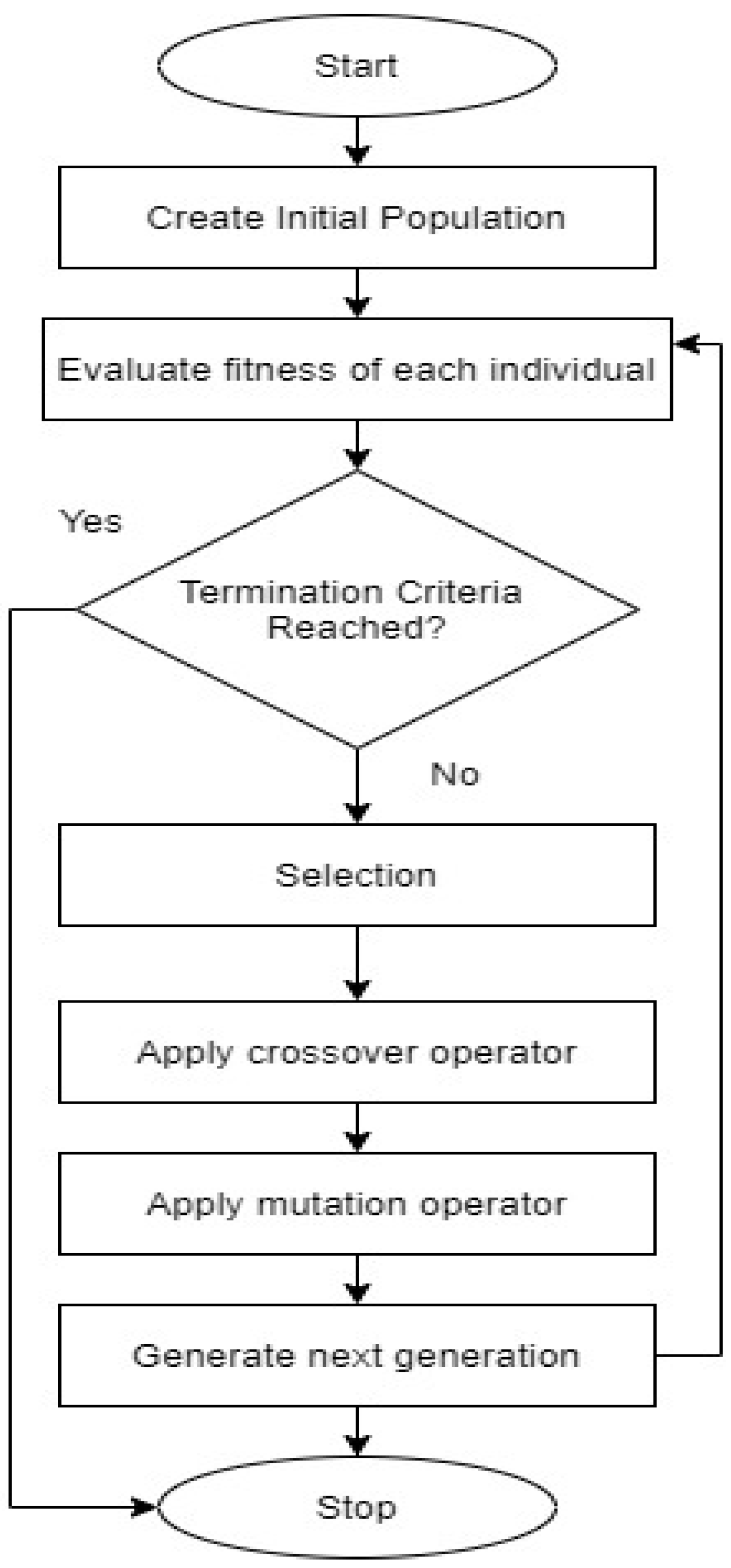Soft Computing Techniques Aware Clustering-Based Routing Protocols in Vehicular Ad Hoc Networks: A Review
Abstract
:1. Introduction
- We present an outline of architecture and characteristics associated with VANET.
- A comprehensive overview of issues and challenges involving vehicular communication is presented.
- A detailed analysis of soft computing-based clustering protocols in VANETs with their goals, strategies, and comparison.
- We present a comparative evaluation of soft computing techniques emphasizing their strengths and limitations.
- Future research directions that can enhance the efficiency of VANETs are introduced.
2. Architecture of VANETs
3. Characteristics of VANETs
- Estimate of movement: The movement of vehicles is limited by the urban structure, such as sidewalks, crossings, and roads, thereby possible vehicle activities can be predictable [16].
- Power constraints: Because every vehicle is fitted with prolonged battery life, the VANETs do not have any power limitations.
- Variable network density: Network density depends upon the traffic in roadside scenarios; in rural areas the density is low, whereas in traffic jams and highly populated urban areas, the density is high.
- Mobility: In VANETs, vehicles usually drive at high velocity. A slight delay in V2V transmission can also lead to several problems.
- Variable Network Topology: Due to the extreme mobility of vehicles, the topology of VANETs varies rapidly. This makes VANETs susceptible to attacks and the detection of malicious vehicles is difficult [17].
- Real-time restrictions: In VANETs, the communication of data has a fixed time threshold range. This is intended to provide ample time for the recipient to make determinations and take necessary actions quickly.
- Processing and storage capacity: In VANETs, it is common to manage vast quantities of data between vehicles and infrastructures. Therefore, the capacity to compute and store is a daunting problem.
- Volatility: It is common for the interactions between two nodes in VANETs to arise only once because of their versatility. The links between nodes will stay within a few wireless hops for a restricted duration of time. Thus, the protection of personal contacts at VANET will be difficult to ensure.
- High processing capacity: Compared to other mobile nodes, operational vehicles can utilize much higher processing, networking, and sensing abilities [18].
- Conventional mobility: Vehicles have motions that are more convenient than traditional MANETs. Vehicles travel only on highways. From GPS technology, roadway information is available.
- Wide scale: With several participants, VANETs could span a whole road network. Its area of coverage can vary from a neighborhood to a whole town.
4. Challenges of VANETs
- Bandwidth limitations: VANETs endure channel overcrowding, particularly in a high-density zone, because of the absence of a central controller that handles the use of restricted bandwidth and comfortable activity [20].
- Delay constraints: Frequent topology changes in VANET have rigorous time rules. Hence, it is important to consider a fair time delay in designing effective vehicle transmission protocols.
- Privacy rights: Vehicular contact must resolve the tradeoff between privacy and accountability. Each car has to believe the source of the data it receives.
- Cross-layering protocols: Real-time applications have rigorous limitations in terms of time and place. The routes are often altered due to the complex topology. Thus, delivering reliable links via the transport layer is effective in such a situation.
- Security threats: Because of the open environment of VANETs, vast amounts of attacks can be targeted. Therefore, it is a challenging problem to discover new incidents related to vehicular interaction and protect the clustering protocols compared to such attacks [21].
- High dynamic and disconnected topology: In order to deal with such conditions, a new research model is therefore implemented called Vehicular Delay Tolerant Networks [22].
5. Taxonomy of Soft Computing Techniques Aware Clustering-Based Routing Protocols in VANETs
5.1. Particle Swarm Optimization
5.2. K-Means Algorithm
- Uses an iterative approach to find the best value for K center points or centroids.
- Assigns each data point to the K center that is nearest to it. A cluster is formed to data points that are closed to a specific K center.
5.3. Neural Network
5.4. Firefly Algorithm
5.5. Fuzzy Logic
5.6. Artificial Bee Colony
5.7. Genetic Algorithm
6. Comparative Analysis
7. Future Scope
- In VANET, due to high-speed network situations, the location of vehicles often changes. In an uneven VANET vehicle density structure, clustering protocols should have a greater ability to predict the exact vehicle location. Clustering techniques based on traffic density may be implemented. The role of the cluster protocol in an uneven vehicle density scenario for precise location prediction may be comprehensively analyzed and can be worked upon.
- In the trustworthiness verification process, vehicles require to discover the requested data. It is hard to handle both trust and user privacy for such procedures. Therefore, to guarantee the trade-off between privacy and trust, a need for a robust cluster-based architecture motivates the researchers to work in this emerging area.
- The proposal on clustering protocols has taken into account urban or highway situations in the literature work. Although, for a hybrid road scenario, a special investigation is needed to improve various network performance parameters. Further, a hybrid approach can also include the real highway speed vehicles in a bidirectional road scenario.
8. Conclusions
Author Contributions
Funding
Institutional Review Board Statement
Informed Consent Statement
Data Availability Statement
Conflicts of Interest
References
- Zhou, H.; Wang, H.; Chen, X.; Li, X.; Xu, S. Data offloading techniques through vehicular ad hoc networks: A survey. IEEE Access 2018, 6, 65250–65259. [Google Scholar] [CrossRef]
- Abdel-Halim, I.T.; Fahmy, H.M.A. Prediction-based protocols for vehicular Ad Hoc Networks: Survey and taxonomy. Comput. Netw. 2018, 130, 34–50. [Google Scholar] [CrossRef]
- Lu, Z.; Qu, G.; Liu, Z. A survey on recent advances in vehicular network security, trust, and privacy. IEEE Trans. Intell. Transp. Syst. 2018, 20, 760–776. [Google Scholar] [CrossRef]
- Tripp-Barba, C.; Zaldívar-Colado, A.; Urquiza-Aguiar, L.; Aguilar-Calderón, J.A. Survey on routing protocols for vehicular ad hoc networks based on multimetrics. Electronics 2019, 8, 1177. [Google Scholar] [CrossRef] [Green Version]
- Cooper, C.; Franklin, D.; Ros, M.; Safaei, F.; Abolhasan, M. A comparative survey of VANET clustering techniques. IEEE Commun. Surv. Tutor. 2016, 19, 657–681. [Google Scholar] [CrossRef]
- Yang, P.; Wang, J.; Zhang, Y.; Tang, Z.; Song, S. Clustering algorithm in VANETs: A survey. In Proceedings of the 2015 IEEE 9th International Conference on Anti-Counterfeiting, Security, and Identification (ASID), Xiamen, China, 25–27 September 2015; pp. 166–170. [Google Scholar]
- Dhasian, H.R.; Balasubramanian, P. Survey of data aggregation techniques using soft computing in wireless sensor networks. IET Inf. Secur. 2013, 7, 336–342. [Google Scholar] [CrossRef]
- Yogarayan, S.; Razak, S.F.A.; Azman, A.; Abdullah, M.F.A. A mini review of peer-to-peer (P2P) for vehicular communication. Indones. J. Electr. Eng. Inform. (IJEEI) 2021, 9, 185–197. [Google Scholar]
- Sharma, S.; Kaul, A.; Ahmed, S.; Sharma, S. A detailed tutorial survey on VANETs: Emerging architectures, applications, security issues, and solutions. Int. J. Commun. Syst. 2021, 34, e4905. [Google Scholar] [CrossRef]
- Weber, J.S.; Neves, M.; Ferreto, T. VANET simulators: An updated review. J. Braz. Comput. Soc. 2021, 27, 1–31. [Google Scholar] [CrossRef]
- Xia, Z.; Wu, J.; Wu, L.; Chen, Y.; Yang, J.; Yu, P.S. A comprehensive survey of the key technologies and challenges surrounding vehicular ad hoc networks. ACM Trans. Intell. Syst. Technol. (TIST) 2021, 12, 1–30. [Google Scholar] [CrossRef]
- Goyal, A.K.; Agarwal, G.; Tripathi, A.K. Network Architectures, Challenges, Security Attacks, Research Domains and Research Methodologies in VANET: A Survey. Int. J. Comput. Netw. Inf. Secur. 2019, 11, 37–44. [Google Scholar] [CrossRef]
- Katiyar, A.; Singh, D.; Yadav, R.S. State-of-the-art approach to clustering protocols in vanet: A survey. Wirel. Netw. 2020, 26, 5307–5336. [Google Scholar] [CrossRef]
- Hande, R.S.; Muddana, A. Comprehensive survey on clustering-based efficient data dissemination algorithms for VANET. In Proceedings of the 2016 International Conference on Signal Processing, Communication, Power and Embedded System (SCOPES), Paralakhemundi, India, 3–5 October 2016; pp. 629–632. [Google Scholar]
- Azam, F.; Kumar, S.; Yadav, K.P.; Priyadarshi, N.; Padmanaban, S. An outline of the security challenges in VANET. In Proceedings of the 2020 IEEE 7th Uttar Pradesh Section International Conference on Electrical, Electronics and Computer Engineering (UPCON), Prayagraj, India, 27–29 November 2020; pp. 1–6. [Google Scholar]
- Sheikh, M.S.; Liang, J. A comprehensive survey on VANET security services in traffic management system. Wirel. Commun. Mob. Comput. 2019, 2019, 2423915. [Google Scholar] [CrossRef] [Green Version]
- Zhang, D.; Zhang, T.; Liu, X. Novel self-adaptive routing service algorithm for application in VANET. Appl. Intell. 2019, 49, 1866–1879. [Google Scholar] [CrossRef]
- Cunha, F.; Villas, L.; Boukerche, A.; Maia, G.; Viana, A.; Mini, R.A.F.; Loureiro, A.A.F. Data communication in VANETs: Protocols, applications and challenges. Ad. Hoc. Netw. 2016, 44, 90–103. [Google Scholar] [CrossRef]
- Hamdi, M.M.; Audah, L.; Rashid, S.A.; Mohammed, A.H.; Alani, S.; Mustafa, A.S. A review of applications, characteristics and challenges in vehicular ad hoc networks (VANETs). In Proceedings of the 2020 International Congress on Human-Computer Interaction, Optimization and Robotic Applications (HORA), Ankara, Turkey, 26–28 June 2020; pp. 1–7. [Google Scholar]
- Shrestha, R.; Bajracharya, R.; Nam, S.Y. Challenges of future VANET and cloud-based approaches. Wirel. Commun. Mob. Comput. 2018, 2018, 5603518. [Google Scholar] [CrossRef]
- Al-Heety, O.S.; Zakaria, Z.; Ismail, M.; Shakir, M.M.; Alani, S.; Alsariera, H. A comprehensive survey: Benefits, services, recent works, challenges, security, and use cases for sdn-vanet. IEEE Access 2020, 8, 91028–91047. [Google Scholar] [CrossRef]
- Eze, E.C.; Zhang, S.J.; Liu, E.J.; Eze, J.C. Advances in vehicular ad-hoc networks (VANETs): Challenges and road-map for future development. Int. J. Autom. Comput. 2016, 13, 1–18. [Google Scholar] [CrossRef] [Green Version]
- Kennedy, J.; Eberhart, R. Particle swarm optimization. In Proceedings of the ICNN’95-International Conference on Neural Networks, Perth, WA, Australia, 27 November–1 December 1995; pp. 1942–1948. [Google Scholar]
- Bao, X.; Li, H.; Zhao, G.; Chang, L.; Zhou, J.; Li, Y. Efficient clustering V2V routing based on PSO in VANETs. Measurement 2020, 152, 107306. [Google Scholar] [CrossRef]
- Sindhwani, M.; Singh, C.; Singh, R. Implementation of k-means algorithm and dynamic routing protocol in VANET. Comput. Syst. Sci. Eng. 2021, 40, 455–467. [Google Scholar] [CrossRef]
- Elhoseny, M.; Shankar, K. Energy efficient optimal routing for communication in VANETs via clustering model. In Emerging Technologies for Connected Internet of Vehicles and Intelligent Transportation System Networks; Springer: Cham, Switzerland, 2019; Volume 242, pp. 1–14. [Google Scholar]
- Ramalingam, M.; Thangarajan, R. Mutated k-means algorithm for dynamic clustering to perform effective and intelligent broadcasting in medical surveillance using selective reliable broadcast protocol in VANET. Comput. Commun. 2020, 150, 563–568. [Google Scholar] [CrossRef]
- Khan, Z.; Fan, P. A novel triple cluster based routing protocol (TCRP) for VANETs. In Proceedings of the 2016 IEEE 83rd Vehicular Technology Conference (VTC Spring), Nanjing, China, 15–18 May 2016; pp. 1–5. [Google Scholar]
- Zhang, G.P. Neural networks for classification: A survey. IEEE Trans. Syst. Man Cybern. Part C (Appl. Rev.) 2000, 30, 451–462. [Google Scholar] [CrossRef] [Green Version]
- Bagherlou, H.; Ghaffari, A. A routing protocol for vehicular ad hoc networks using simulated annealing algorithm and neural networks. J. Supercomput. 2018, 74, 2528–2552. [Google Scholar] [CrossRef]
- Mohammadnezhad, M.; Ghaffari, A. Hybrid routing scheme using imperialist competitive algorithm and RBF neural networks for VANETs. Wirel. Netw. 2019, 25, 2831–2849. [Google Scholar] [CrossRef]
- Singh, G.D.; Prateek, M.; Kumar, S.; Verma, M.; Singh, D.; Lee, H.N. Hybrid genetic firefly algorithm-based routing protocol for VANETs. IEEE Access 2022, 10, 9142–9151. [Google Scholar] [CrossRef]
- Joshua, C.J.; Duraisamy, R.; Varadarajan, V. A reputation based weighted clustering protocol in VANET: A multi-objective firefly approach. Mob. Netw. Appl. 2019, 24, 1199–1209. [Google Scholar] [CrossRef]
- Debnath, A.; Basumatary, H.; Dhar, M.; Debbarma, M.K.; Bhattacharyya, B.K. Fuzzy logic-based VANET routing method to increase the QoS by considering the dynamic nature of vehicles. Computing 2021, 103, 1391–1415. [Google Scholar] [CrossRef]
- Moridi, E.; Barati, H. RMRPTS: A reliable multi-level routing protocol with tabu search in VANET. Telecommun. Syst. 2017, 65, 127–137. [Google Scholar] [CrossRef]
- Baskaran, R.; Basha, M.S.; Amudhavel, J.; Kumar, K.P.; Kumar, D.A.; Vijayakumar, V. A bio-inspired artificial bee colony approach for dynamic independent connectivity patterns in VANET. In Proceedings of the 2015 International Conference on Circuits, Power and Computing Technologies [ICCPCT-2015], Nagercoil, India, 19–20 March 2015; pp. 1–6. [Google Scholar]
- Fekair, M.E.A.; Lakas, A.; Korichi, A. CBQoS-Vanet: Cluster-based artificial bee colony algorithm for QoS routing protocol in VANET. In Proceedings of the 2016 International Conference on Selected Topics in Mobile & Wireless Networking (MoWNeT), Cairo, Egypt, 11–13 April 2016; pp. 1–8. [Google Scholar]
- Mirjalili, S. Genetic algorithm. In Evolutionary Algorithms and Neural Networks; Springer: Cham, Switzerland, 2019; pp. 43–55. [Google Scholar]
- Hadded, M.; Zagrouba, R.; Laouiti, A.; Muhlethaler, P.; Saidane, L.A. A multi-objective genetic algorithm-based adaptive weighted clustering protocol in vanet. In Proceedings of the 2015 IEEE Congress on Evolutionary Computation (CEC), Sendai, Japan, 25–28 May 2015; pp. 994–1002. [Google Scholar]








| Protocols | Soft Computing Technique | Issue Addressed | Parameters | Metrics |
|---|---|---|---|---|
| Bao et al. [24] | PSO | Provide efficient and reliable information exchange | Node’s position Node’s velocity Node’s neighbors | PDR E2E delay |
| Elhoseny et al. [26] | K-means | Improve node lifetime and link lifetime | Distance | Energy consumption |
| Ramalingam et al. [27] | K-means | Provide effective information transmission between vehicles | Distance | PDR |
| Khan et al. [28] | K-means | Minimize the traffic overhead | Average distance | Energy consumption Delay |
| Bagherlou et al. [30] | NN | Provide a stable and reliable communication | Node degree Coverage ability | Route discovery rate PDR |
| Mohammadnezhad et al. [31] | NN | Manage the dynamic nature of vehicle nodes and unstable wireless links | Node degree Speed of vehicles | PDR Throughput E2E delay |
| Joshua et al. [33] | FA | Efficiently handle the changing topology of VANETs | Vehicle direction Location Speed Nearby vehicles Status of each node | Mean cluster lifetime PDR Control packet overhead |
| Moridi et al. [35] | FL | Enhance the stability of the network topology | Node’s distance Velocity Angle Reliability | PDR E2E delay Packet loss rate |
| Fekair et al. [37] | ABC | Provide a higher level of quality of services (QoS) for real-time applications | Existing bandwidth E2E delay Jitter Connection expiration period | PDR E2E delay Network overhead |
| Hadded et al. [39] | GA | Improve AODV routing between cluster members. | Highway ID Vehicle direction Location Speed Neighboring vehicles | Data delivery rate Clustering overheads |
| CI Techniques | Advantages | Disadvantages |
|---|---|---|
| PSO | Because of its simplicity in executing on hardware or software, and highly optimum result, PSO is the most prevalent soft computing technique used in VANETs. | The PSO’s iterative design does not make it ideal for real-time services. |
| K-means | Comparatively easy to implement. Guarantees convergence. | Difficult to approximate K-value. It did not fit properly with a global cluster. |
| NN | NNs will deal with incomplete sets of data. NNs are useful for prediction. | In complex ANN systems, excessive training can be needed. |
| FA | For determining the fitness function, the FA has relatively fewer parameters. | It is not successful in defining the high-performing regions in the search space for complicated issues. |
| FL | The least system improvement cost, design time, and computing memory are needed to execute FL. | Fuzzy laws do not conform to the complexities of the network and need to be re-learned under difficult network circumstances. |
| ABC | The ABC algorithm attains global optimization through discovery by artificial scouts, while local optimization is achieved by exploitation of onlookers and employed bees. | Because of the random solution, ABC has a sluggish convergence issue. |
| GA | The inherent parallel environment makes GAs appropriate for the process of data collection. | GA has a slow speed of convergence that limits its execution in real-time applications. |
Publisher’s Note: MDPI stays neutral with regard to jurisdictional claims in published maps and institutional affiliations. |
© 2022 by the authors. Licensee MDPI, Basel, Switzerland. This article is an open access article distributed under the terms and conditions of the Creative Commons Attribution (CC BY) license (https://creativecommons.org/licenses/by/4.0/).
Share and Cite
Sindhwani, M.; Sachdeva, S.; Arora, K.; Yoon, T.; Yoo, D.; Joshi, G.P.; Cho, W. Soft Computing Techniques Aware Clustering-Based Routing Protocols in Vehicular Ad Hoc Networks: A Review. Appl. Sci. 2022, 12, 7922. https://doi.org/10.3390/app12157922
Sindhwani M, Sachdeva S, Arora K, Yoon T, Yoo D, Joshi GP, Cho W. Soft Computing Techniques Aware Clustering-Based Routing Protocols in Vehicular Ad Hoc Networks: A Review. Applied Sciences. 2022; 12(15):7922. https://doi.org/10.3390/app12157922
Chicago/Turabian StyleSindhwani, Manoj, Shippu Sachdeva, Krishan Arora, Taehyun Yoon, Daeseung Yoo, Gyanendra Prasad Joshi, and Woong Cho. 2022. "Soft Computing Techniques Aware Clustering-Based Routing Protocols in Vehicular Ad Hoc Networks: A Review" Applied Sciences 12, no. 15: 7922. https://doi.org/10.3390/app12157922
APA StyleSindhwani, M., Sachdeva, S., Arora, K., Yoon, T., Yoo, D., Joshi, G. P., & Cho, W. (2022). Soft Computing Techniques Aware Clustering-Based Routing Protocols in Vehicular Ad Hoc Networks: A Review. Applied Sciences, 12(15), 7922. https://doi.org/10.3390/app12157922








